Recent Trends on Liquid Air Energy Storage: A Bibliometric Analysis
Abstract
1. Introduction
2. Methodology
3. Results and Discussion
3.1. Publications Trend and Distribution by Journal and Subject
3.2. Document Type of Publications
3.3. Distribution of Publications by Institution
3.4. Countries Distribution
3.5. Authorship Analysis
3.6. Analysis of Keywords
4. Conclusions
- Most of the approaches in the study of LAES have been based on thermodynamic and exergy analysis of the system with the aim to estimate the efficiency of the LAES and propose solutions to increase the system performance, which is currently the major drawback of this technology.
- The keyword analysis also showed that part of the research on the topic of LAES was interested in investigating the economic feasibility of the system. However, the relevance of keywords related to the economic aspect was lower compared to terms related to the thermodynamic analysis, identifying the first research gap.
- The last trend in the research of LAES aims for the integration of this technology with other external systems that allow for the exploitation of waste thermal energy. The most common system integrated to the LAES as a waste heat recovery solution is the organic Rankine cycle (ORC), while at low temperatures, different studies in the literature have used the LAES technology to exploit the waste cold thermal energy from cryogenic processes such as in liquefied natural gas regasification plants. Studies on how to efficiently store the cold and the hot energy wasted from the LAES represent another trend in the last research. Indeed, recovering cold energy is demonstrated to be crucial to increase the efficiency of the liquefaction process. On the other hand, the recovery of the waste heat can improve the discharge performance. Therefore, the research of new storage materials and thermal energy storage designed to efficiently store the cold and hot energy, represents a hotspot that future research should take into account to improve the LAES technology.
- The analysis of the keywords lacked terms related to experimental studies that demonstrate the real performance of the system. This shows that this aspect is weak and has not been deeply investigated. This represents the main gap that future scientific research should fill in to reach a significant milestone in the LAES technology.
Author Contributions
Funding
Acknowledgments
Conflicts of Interest
References
- Int. Energy Agency. World Energy Outlook 2019; Int. Energy Agency: Paris, France, 2019. [Google Scholar]
- Zhang, X. Energy Solutions to Combat Global Warming; Springer International Publishing: Cham, Switzerland, 2017; ISBN 978-3-319-26948-1. [Google Scholar]
- Anil, M.; Saygin, D.; Miketa, A.; Gielen, D.; Nicholas, W. The True Cost of Fossil Fuels: Saving on the Externalities of Air Pollution And Climate Change; International Renewable Energy Agency: Abu Dhabi, UAE, 2016. [Google Scholar]
- Lott, M.C.; Kim, S.-I.; Tam, C.; Houssin, D.; Gagné, J.F. Technology Roadmap: Energy Storage; Int. Energy Agency (IEA): Paris, France, 2014. [Google Scholar]
- Chen, H.; Cong, T.N.; Yang, W.; Tan, C.; Li, Y.; Ding, Y. Progress in electrical energy storage system: A critical review. Prog. Nat. Sci. 2009, 19, 291–312. [Google Scholar] [CrossRef]
- Luo, X.; Wang, J.; Dooner, M.; Clarke, J. Overview of current development in electrical energy storage technologies and the application potential in power system operation q. Appl. Energy 2015, 137, 511–536. [Google Scholar] [CrossRef]
- Morgan, R.; Nelmes, S.; Gibson, E.; Brett, G. An analysis of a large-scale liquid air energy storage system. Proc. Inst. Civ. Eng. 2015, 168, 135–144. [Google Scholar] [CrossRef]
- Kim, J.; Noh, Y.; Chang, D. Storage system for distributed-energy generation using liquid air combined with liquefied natural gas. Appl. Energy 2018, 212, 1417–1432. [Google Scholar] [CrossRef]
- Tafone, A.; Borri, E.; Li, Y. Techno-economic analysis of a Liquid Air Energy Storage (LAES ) for cooling application in hot climates. Energy Procedia 2016, 105, 4450–4457. [Google Scholar] [CrossRef]
- Liquid Air Energy Network. The Cold Economy (Guide); Liquid Air Energy Network: London, UK, 2014; Available online: https://dearman.co.uk/media/reports-guides/ (accessed on 16 April 2020).
- Comodi, G.; Carducci, F.; Sze, J.Y.; Balamurugan, N.; Romagnoli, A. Storing energy for cooling demand management in tropical climates: A techno-economic comparison between different energy storage technologies. Energy 2017, 121, 676–694. [Google Scholar] [CrossRef]
- Tafone, A.; Romagnoli, A.; Borri, E.; Comodi, G. New parametric performance maps for a novel sizing and selection methodology of a Liquid Air Energy Storage system. Appl. Energy 2019, 250, 1641–1656. [Google Scholar] [CrossRef]
- van Raan, A.F.J. For your citations only? Hot topics in bibliometric analysis. Meas. Interdiscip. Res. Perspect. 2005, 3, 50–62. [Google Scholar] [CrossRef]
- Mao, G.; Zou, H.; Chen, G.; Du, H.; Zuo, J. Past, current and future of biomass energy research: A bibliometric analysis. Renew. Sustain. Energy Rev. 2015, 52, 1823–1833. [Google Scholar] [CrossRef]
- Calderón, A.; Barreneche, C.; Hernández-Valle, K.; Galindo, E.; Segarra, M.; Fernández, A.I. Where is Thermal Energy Storage (TES) research going?—A bibliometric analysis. Sol. Energy 2019, 200, 37–50. [Google Scholar] [CrossRef]
- Bartolini, M.; Bottani, E.; Grosse, E.H. Green warehousing: Systematic literature review and bibliometric analysis. J. Clean. Prod. 2019, 226, 242–258. [Google Scholar] [CrossRef]
- Du, H.; Li, N.; Brown, M.A.; Peng, Y.; Shuai, Y. A bibliographic analysis of recent solar energy literatures: The expansion and evolution of a research field. Renew. Energy 2014, 66, 696–706. [Google Scholar] [CrossRef]
- Cabeza, L.F.; Chàfer, M.; Mata, É. Comparative Analysis of Web of Science and Scopus on the Energy Efficiency and Climate Impact of Buildings. Energies 2020, 13, 409. [Google Scholar] [CrossRef]
- Falagas, M.E.; Pitsouni, E.I.; Malietzis, G.A.; Pappas, G. Comparison of PubMed, Scopus, web of science, and Google scholar: Strengths and weaknesses. FASEB J. 2008, 22, 338–342. [Google Scholar] [CrossRef] [PubMed]
- Lee, I.; Park, J.; Moon, I. Conceptual design and exergy analysis of combined cryogenic energy storage and LNG regasification processes: Cold and power integration. Energy 2017, 140, 106–115. [Google Scholar] [CrossRef]
- Van Eck, N.; Waltman, L. Software survey: VOSviewer, a computer program for bibliometric mapping. Scientometrics 2010, 84, 523–538. [Google Scholar] [CrossRef]
- Shepherd, D.G. A Low-Pollution On-Site, Energy Storage System for Peak-Power Supply. In Proceedings of the ASME 1974 International Gas Turbine Conference and Products Show, Zurich, Switzerland, 30 March–4 April 1974; American Society of Mechanical Engineers Digital Collection: New York, NY, USA, 1974. [Google Scholar]
- Smith, E.M. Storage of Electrical Energy Using Supercritical Liquid Air. Proc. Inst. Mech. Eng. 1977, 191, 289–298. [Google Scholar] [CrossRef]
- de Marchi Desenzani, P. Remote new energy sources utilization in on-site non-polluting power plant-Liquid air as energy carrier concept and final conversion plant design. In Proceedings of the Alternative Energy Sources Miami International Conference, Miami Beach, FL, USA, 5–7 December 1977; Volume 9, pp. 4091–4103. [Google Scholar]
- Dooley, J.L. COMPACT ENERGY STORAGE 82-1696 JL Dooley* and R. Philip Hammond R&D Associates, Marina del Rey, CA 90291. In Proceedings of the A Collection of Technical Papers: AIAA/EPRI International Conference on Underground Pumped Hydro and Compressed Air Energy Storage, San Francisco, CA, USA, 20–22 September 1982; American Institute of Aeronautics and Astronautics: Reston, VA, USA, 1982; Volume 120, p. 288. [Google Scholar]
- Kitou, K.; Fujii, T.; Shiina, K.; Chino, K. Liquid air energy storage system (study of air liquefaction characteristics using a concrete-type cool storage unit). Nippon Kikai Gakkai Ronbunshu B Hen/Trans. Jpn. Soc. Mech. Eng. Part B 2002, 68, 2870–2876. [Google Scholar]
- Araki, H.; Nakabaru, M.; Chino, K. Simulation of heat transfer in the cool storage unit of a liuid-air energy storage system. Heat Transf.-Asian Res. 2002, 31, 284–296. [Google Scholar] [CrossRef]
- Araki, H.; Nakabaru, M.; Chino, K. Heat transfer performance of new-style LNG heat exchangers. Nihon Kikai Gakkai Ronbunshu B Hen/Trans. Jpn. Soc. Mech. Eng. Part B 2001, 67, 1451–1458. [Google Scholar]
- Araki, H.; Kitoh, K.; Chino, K. Heat transfer in the regenerator of a liquid air energy storage system. American Society of Mechanical Engineers, Advanced Energy Systems Division (Publication) AES 2000, 40, 373–378. [Google Scholar]
- Chino, K.; Araki, H. Evaluation of energy storage method using liquid air. Heat Transf. Asian Res. 2000, 29, 347–357. [Google Scholar] [CrossRef]
- Kito, K.; Shiina, K.; Chino, K. Liquid air energy storage system (heat transfer characteristics of concrete cool storage unit). Nihon Kikai Gakkai Ronbunshu B Hen/Trans. Jpn. Soc. Mech. Eng. Part B 2000, 66, 1541. [Google Scholar]
- Sciacovelli, A.; Smith, D.; Navarro, H.; Li, Y.; Ding, Y. Liquid air energy storage–Operation and performance of the first pilot plant in the world. In Proceedings of the ECOS, Portorož, Slovenia, 19–23 June 2016. [Google Scholar]
- Morgan, R.; Nelmes, S.; Gibson, E.; Brett, G. Liquid air energy storage—Analysis and first results from a pilot scale demonstration plant. Appl. Energy 2015, 137, 845–853. [Google Scholar] [CrossRef]
- Park, J.; Lee, I.; You, F.; Moon, I. Economic Process Selection of Liquefied Natural Gas Regasification: Power Generation and Energy Storage Applications. Ind. Eng. Chem. Res. 2019, 58, 4946–4956. [Google Scholar] [CrossRef]
- Lee, I.; Park, J.; You, F.; Moon, I. A novel cryogenic energy storage system with LNG direct expansion regasification: Design, energy optimization, and exergy analysis. Energy 2019, 173, 691–705. [Google Scholar] [CrossRef]
- Highview Power. Available online: https://www.highviewpower.com/ (accessed on 16 April 2020).
- Peng, X.; She, X.; Li, C.; Luo, Y.; Zhang, T.; Li, Y.; Ding, Y. Liquid air energy storage flexibly coupled with LNG regasification for improving air liquefaction. Appl. Energy 2019, 250, 1190–1201. [Google Scholar] [CrossRef]
- She, X.; Zhang, T.; Cong, L.; Peng, X.; Li, C.; Luo, Y.; Ding, Y. Flexible integration of liquid air energy storage with liquefied natural gas regasification for power generation enhancement. Appl. Energy 2019, 251, 113355. [Google Scholar] [CrossRef]
- She, X.; Peng, X.; Nie, B.; Leng, G.; Zhang, X.; Weng, L.; Tong, L.; Zheng, L.; Wang, L.; Ding, Y. Enhancement of round trip efficiency of liquid air energy storage through effective utilization of heat of compression. Appl. Energy 2017, 206, 1632–1642. [Google Scholar] [CrossRef]
- Borri, E.; Tafone, A.; Romagnoli, A.; Comodi, G. A preliminary study on the optimal configuration and operating range of a “microgrid scale” air liquefaction plant for Liquid Air Energy Storage. Energy Convers. Manag. 2017, 143, 275–285. [Google Scholar] [CrossRef]
- Tafone, A.; Borri, E.; Comodi, G.; van den Broek, M.; Romagnoli, A. Liquid Air Energy Storage performance enhancement by means of Organic Rankine Cycle and Absorption Chiller. Appl. Energy 2018, 228, 1810–1821. [Google Scholar] [CrossRef]
- Antonelli, M.; Desideri, U.; Giglioli, R.; Paganucci, F.; Pasini, G. Liquid air energy storage: A potential low emissions and efficient storage system. Energy Procedia 2016, 88, 693–697. [Google Scholar] [CrossRef]
- Antonelli, M.; Barsali, S.; Desideri, U.; Giglioli, R.; Paganucci, F.; Pasini, G. Liquid air energy storage: Potential and challenges of hybrid power plants. Appl. Energy 2017, 194, 522–529. [Google Scholar] [CrossRef]
- Barsali, S.; Ciambellotti, A.; Giglioli, R.; Paganucci, F.; Pasini, G. Hybrid power plant for energy storage and peak shaving by liquefied oxygen and natural gas. Appl. Energy 2018, 228, 33–41. [Google Scholar] [CrossRef]
- Negro, D.; Brown, T.; Foster, A.; Damas, A.; Tovar Ramos, J.E.; Evans, J. Modelling of liquid air energy storage applied to refrigerated cold stores. In Proceedings of the 5th IIR Conference on Sustainability and the Cold Chain (ICCC 2018), Beijing, China, 6–8 April 2018; IIR: Paris, France, 2018. [Google Scholar]
- Krawczyk, P.; Szabłowski, Ł.; Karellas, S.; Kakaras, E.; Badyda, K. Comparative thermodynamic analysis of compressed air and liquid air energy storage systems. Energy 2018, 142, 46–54. [Google Scholar] [CrossRef]
- Li, Y.; Wang, X.; Li, D.; Ding, Y. A trigeneration system based on compressed air and thermal energy storage. Appl. Energy 2012, 99, 316–323. [Google Scholar] [CrossRef]
- Lee, I.; You, F. Systems design and analysis of liquid air energy storage from liquefied natural gas cold energy. Appl. Energy 2019, 242, 168–180. [Google Scholar] [CrossRef]
- Guizzi, G.L.; Manno, M.; Tolomei, L.M.; Vitali, R.M. Thermodynamic analysis of a liquid air energy storage system. Energy 2015, 93, 1639–1647. [Google Scholar] [CrossRef]
- Xue, X.D.; Wang, S.X.; Zhang, X.L.; Cui, C.; Chen, L.B.; Zhou, Y.; Wang, J.J. Thermodynamic analysis of a novel liquid air energy storage system. Phys. Procedia 2015, 67, 733–738. [Google Scholar] [CrossRef]
- Xie, C.; Hong, Y.; Ding, Y.; Li, Y.; Radcliffe, J. An economic feasibility assessment of decoupled energy storage in the UK: With liquid air energy storage as a case study. Appl. Energy 2018, 225, 244–257. [Google Scholar] [CrossRef]
- Hamdy, S.; Morosuk, T.; Tsatsaronis, G. Cryogenics-based energy storage: Evaluation of cold exergy recovery cycles. Energy 2017, 138, 1069–1080. [Google Scholar] [CrossRef]
- Hamdy, S.; Morosuk, T.; Tsatsaronis, G. Exergetic and economic assessment of integrated cryogenic energy storage systems. Cryogenics (Guildf) 2019, 99, 39–50. [Google Scholar] [CrossRef]
- Peng, X.; She, X.; Cong, L.; Zhang, T.; Li, C.; Li, Y.; Wang, L.; Tong, L.; Ding, Y. Thermodynamic study on the effect of cold and heat recovery on performance of liquid air energy storage. Appl. Energy 2018, 221, 86–99. [Google Scholar] [CrossRef]
- Zhang, T.; Chen, L.; Zhang, X.; Mei, S.; Xue, X.; Zhou, Y. Thermodynamic analysis of a novel hybrid liquid air energy storage system based on the utilization of LNG cold energy. Energy 2018, 155, 641–650. [Google Scholar] [CrossRef]
- Hüttermann, L.; Span, R. Influence of the heat capacity of the storage material on the efficiency of thermal regenerators in liquid air energy storage systems. Energy 2019, 174, 236–245. [Google Scholar] [CrossRef]
- Sciacovelli, A.; Vecchi, A.; Ding, Y. Liquid air energy storage (LAES) with packed bed cold thermal storage—From component to system level performance through dynamic modelling. Appl. Energy 2017, 190, 84–98. [Google Scholar] [CrossRef]
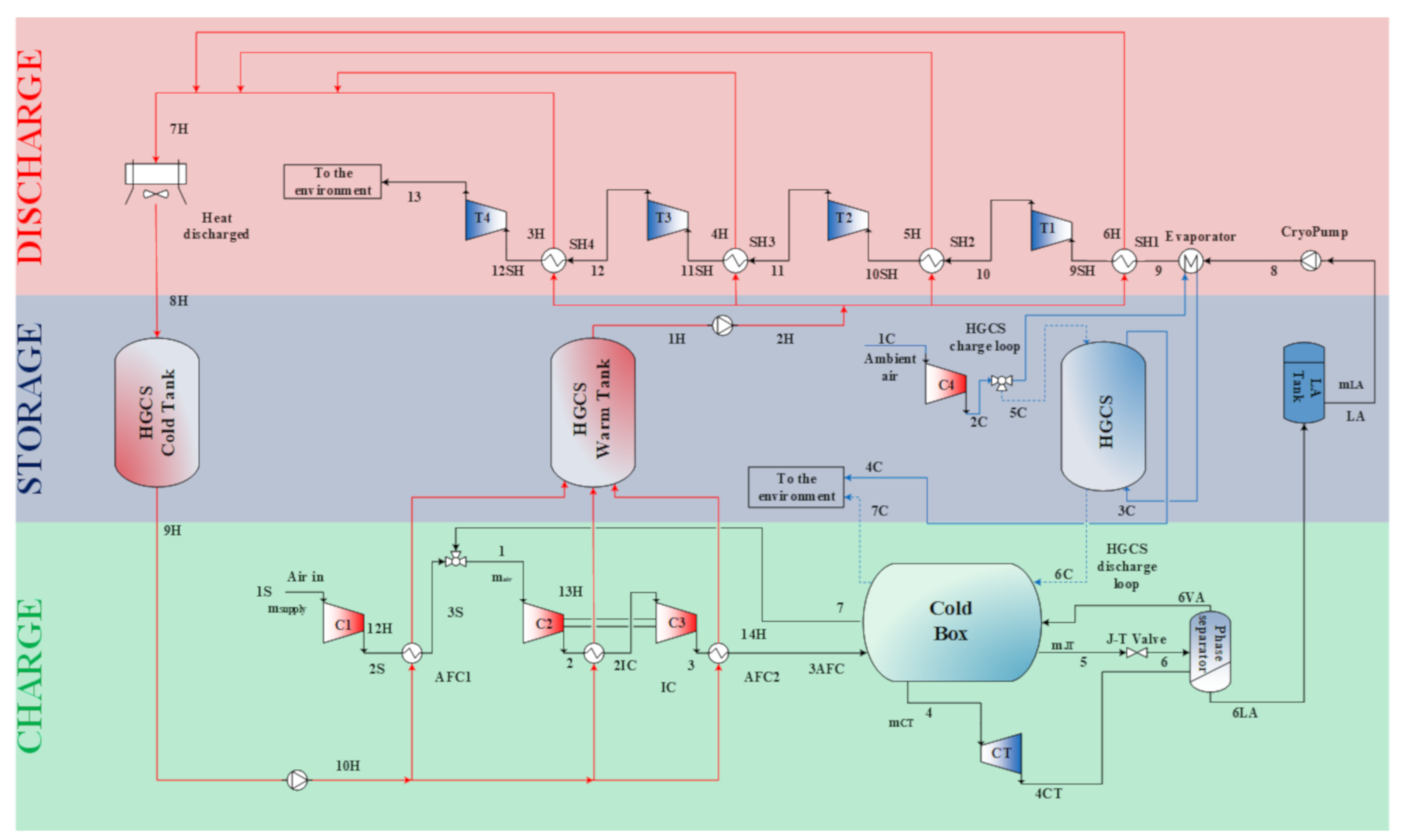
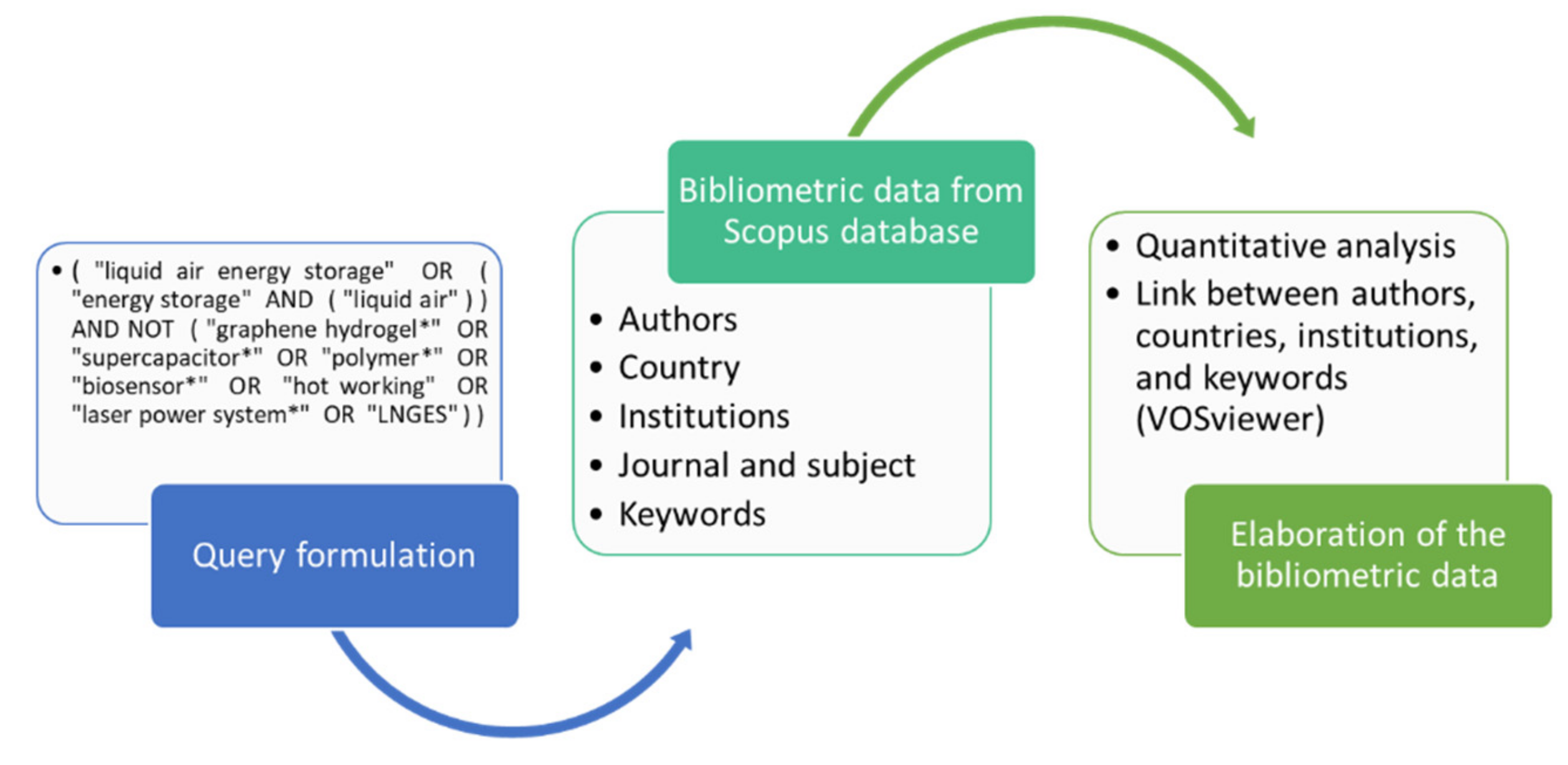


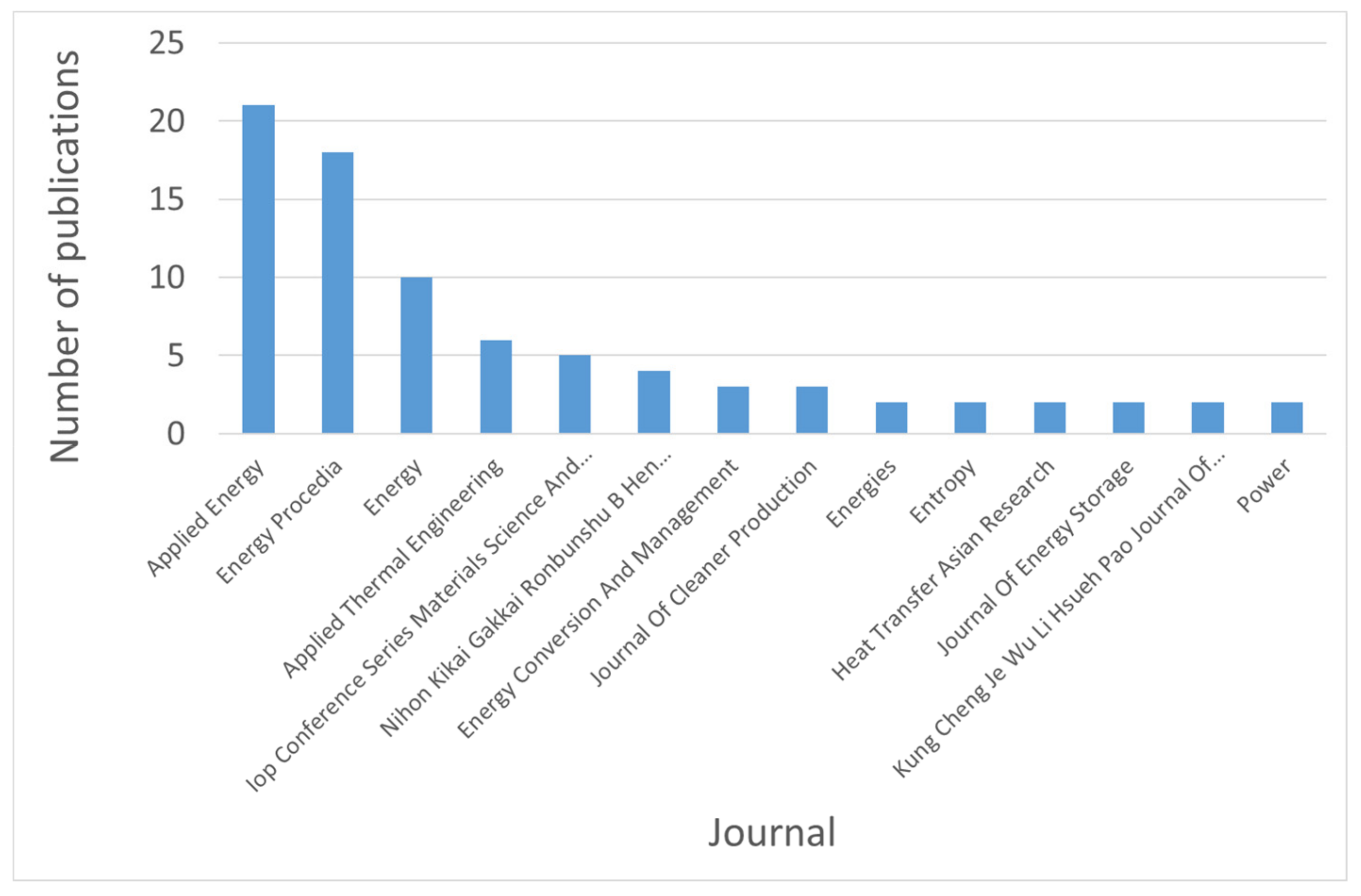
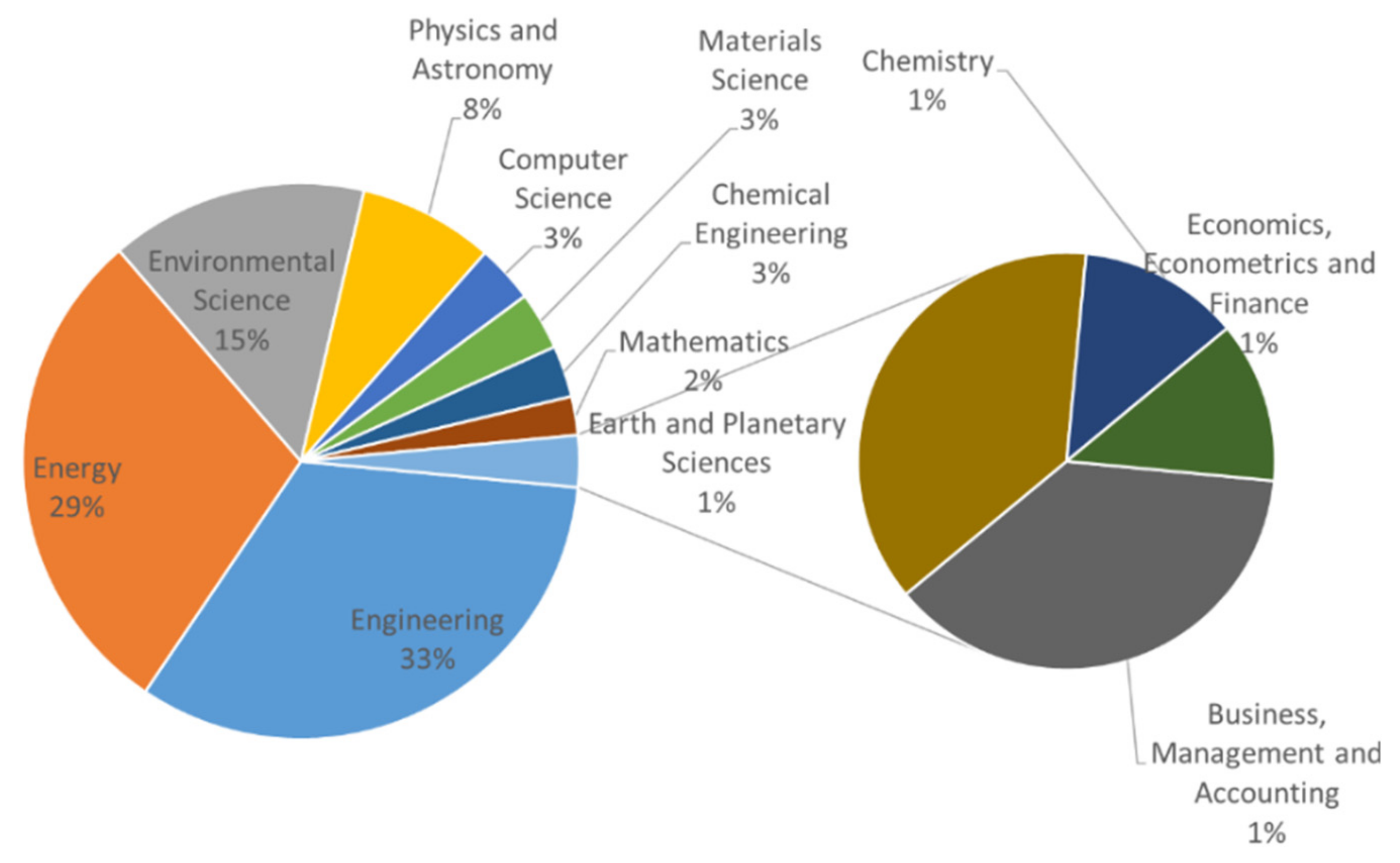
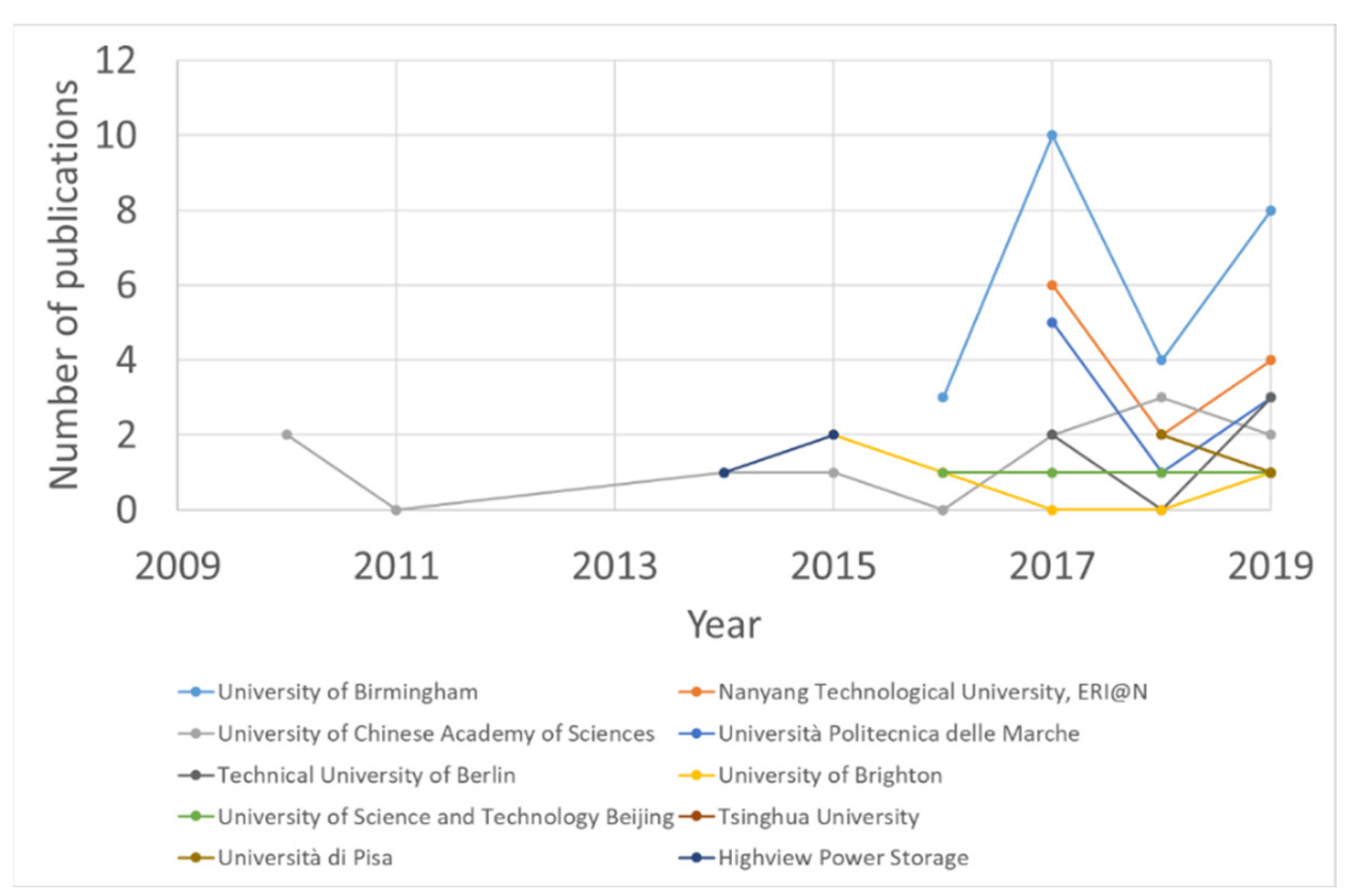
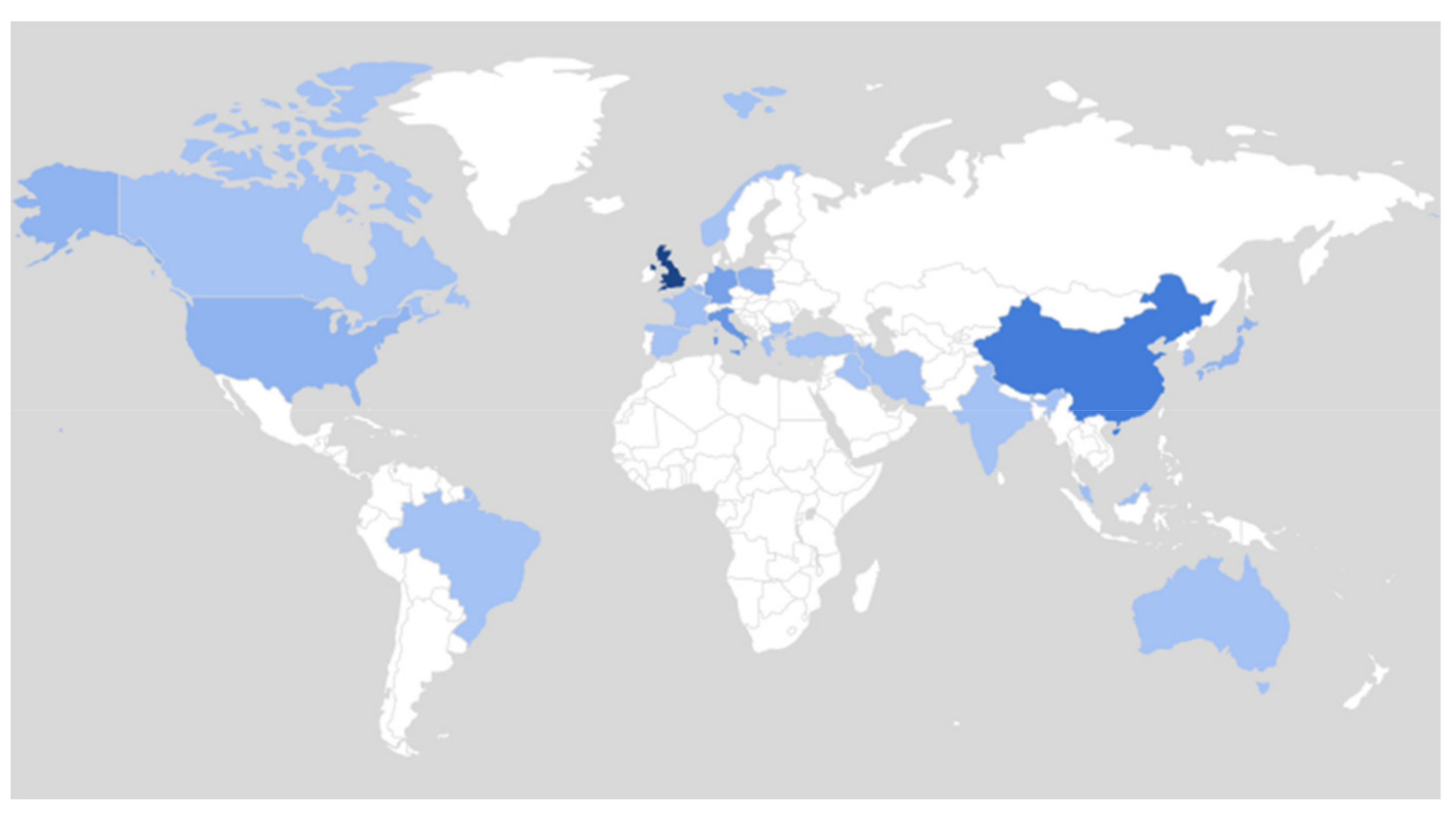
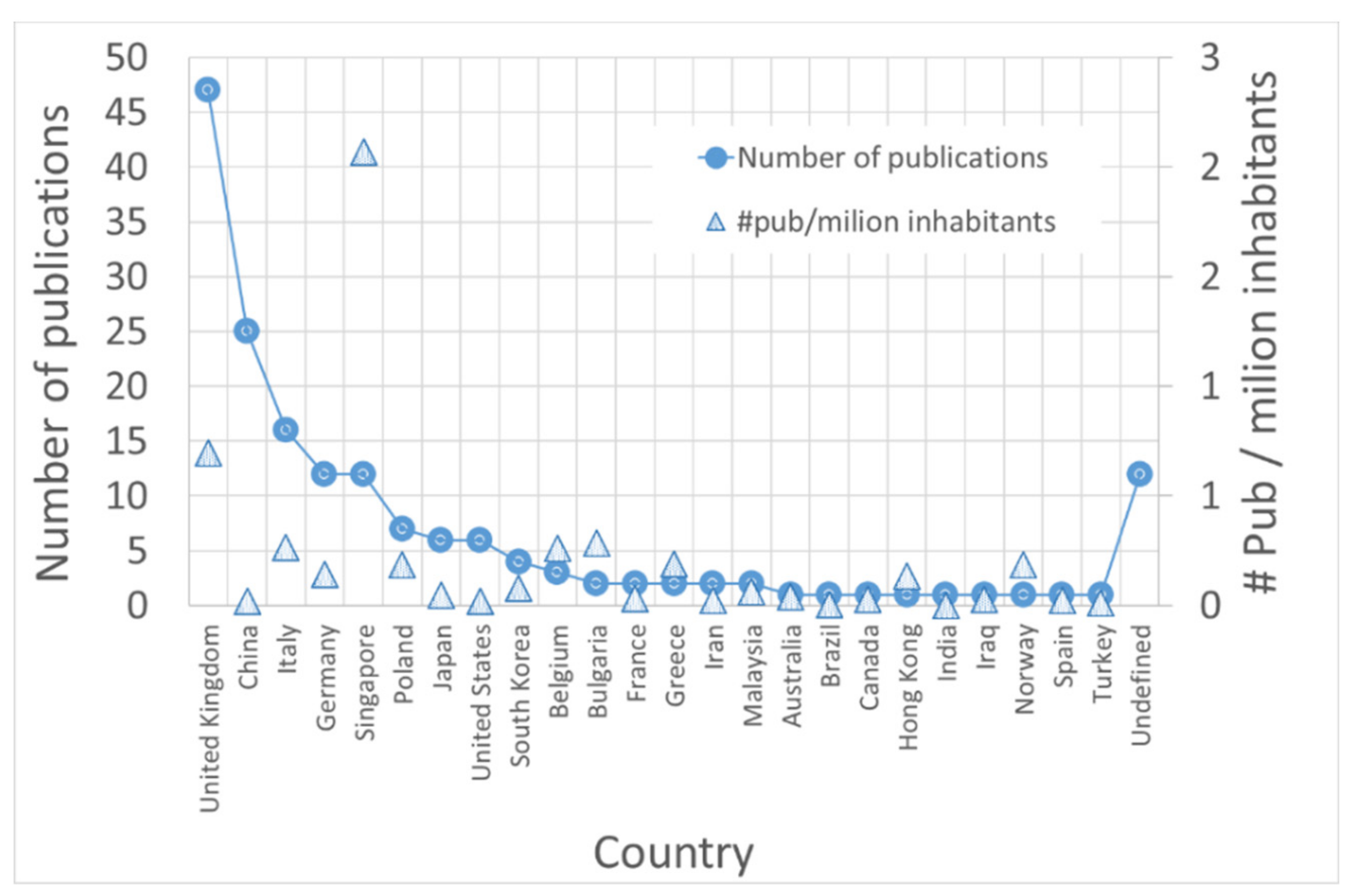
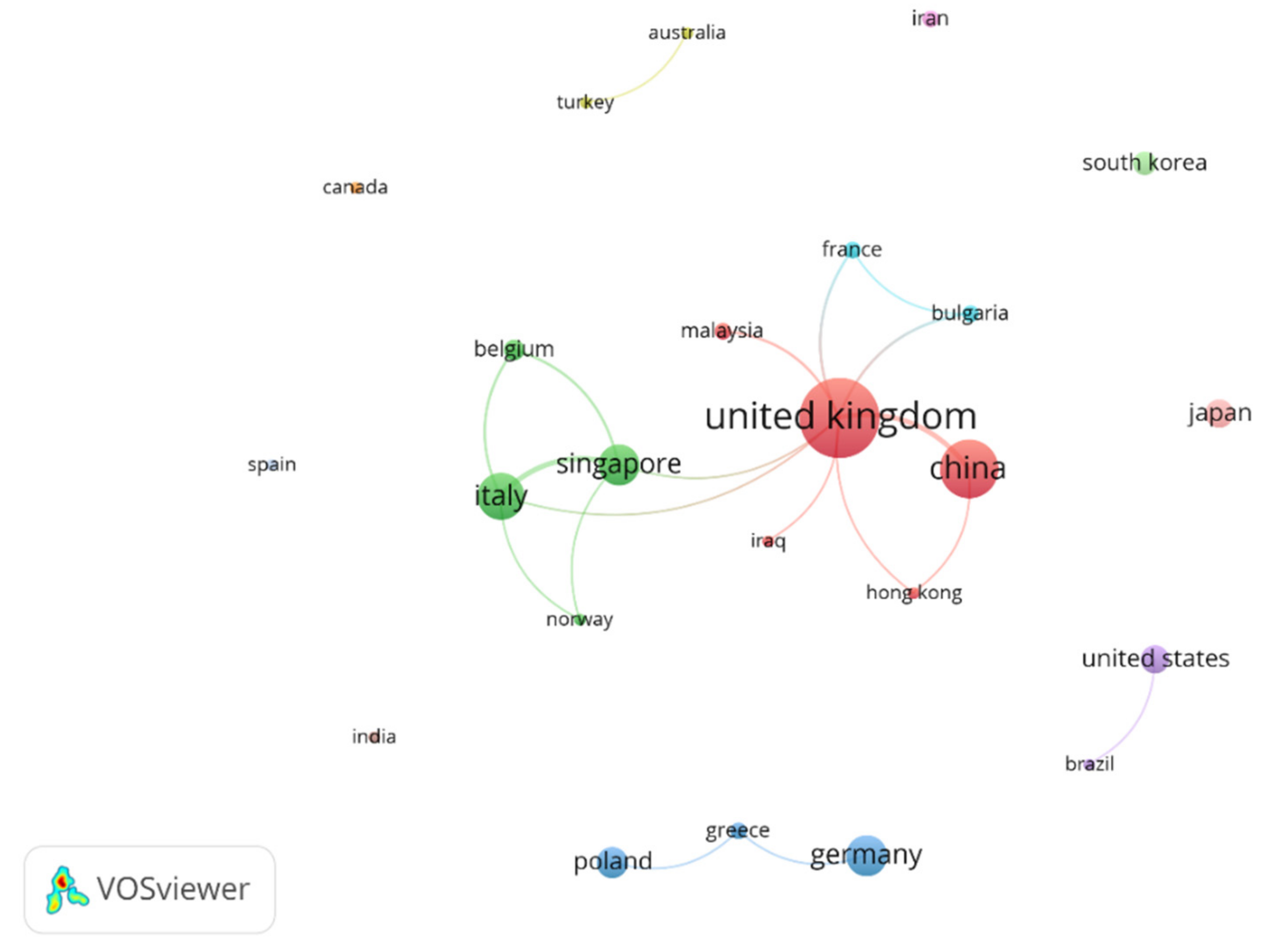
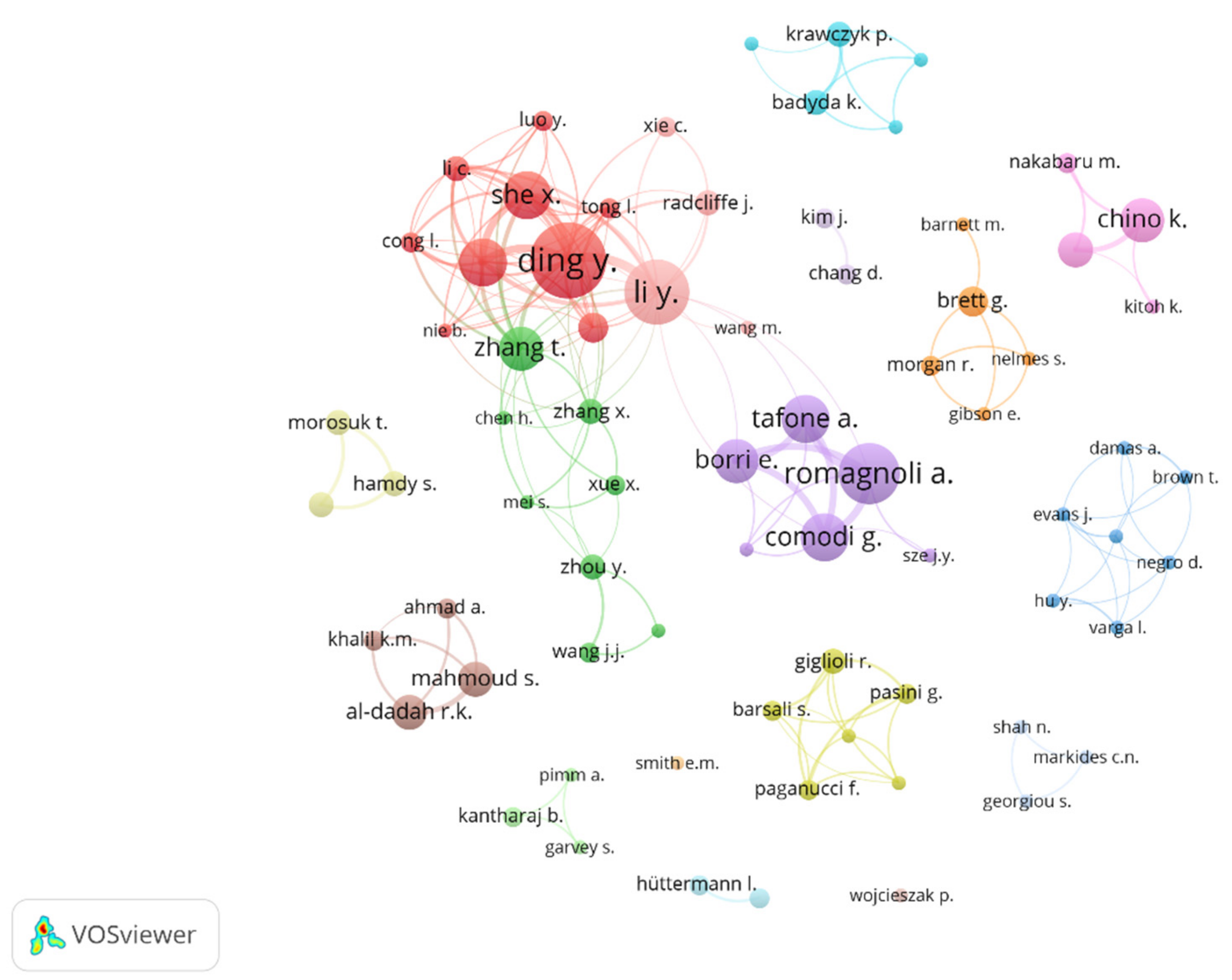
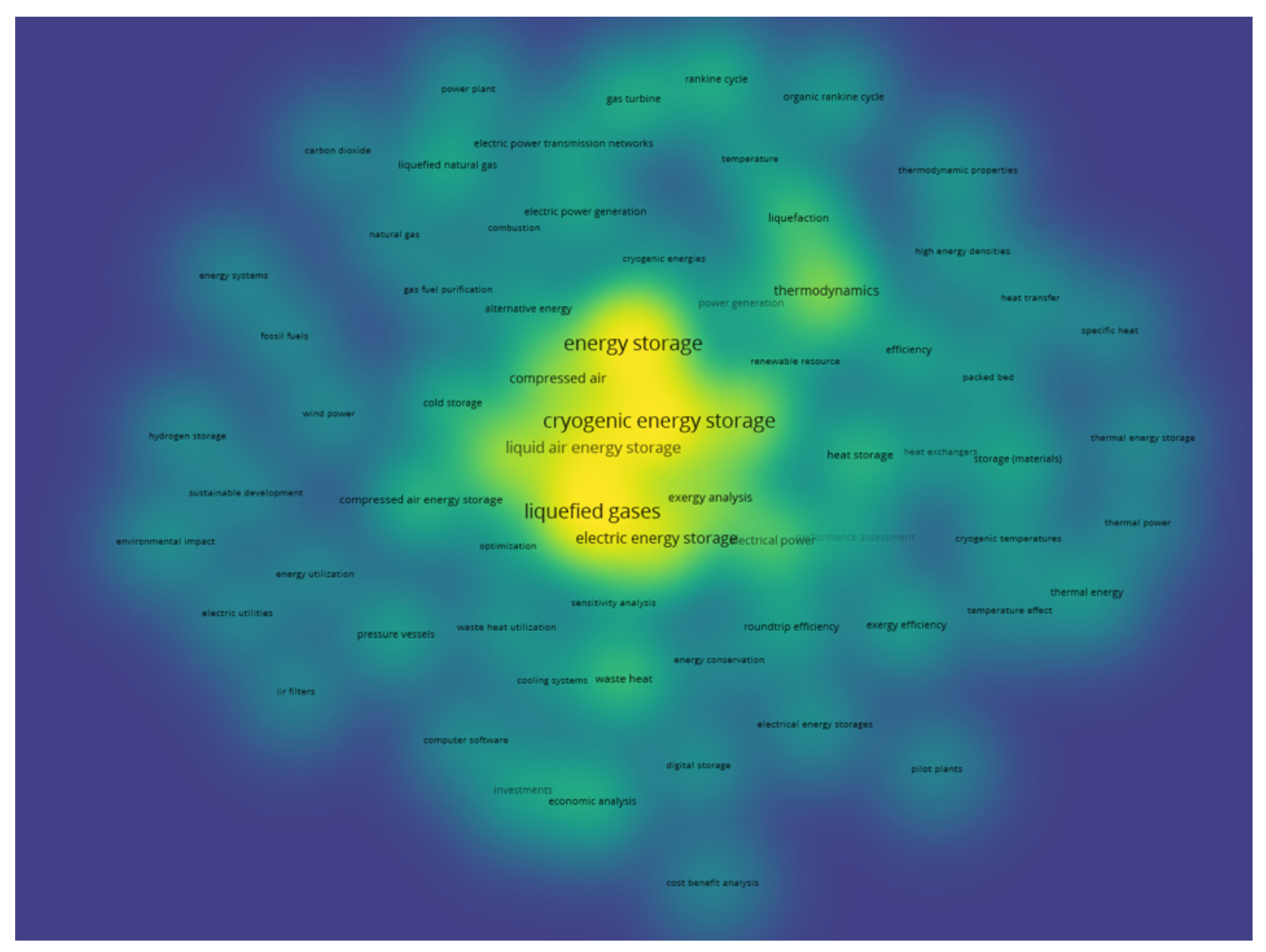
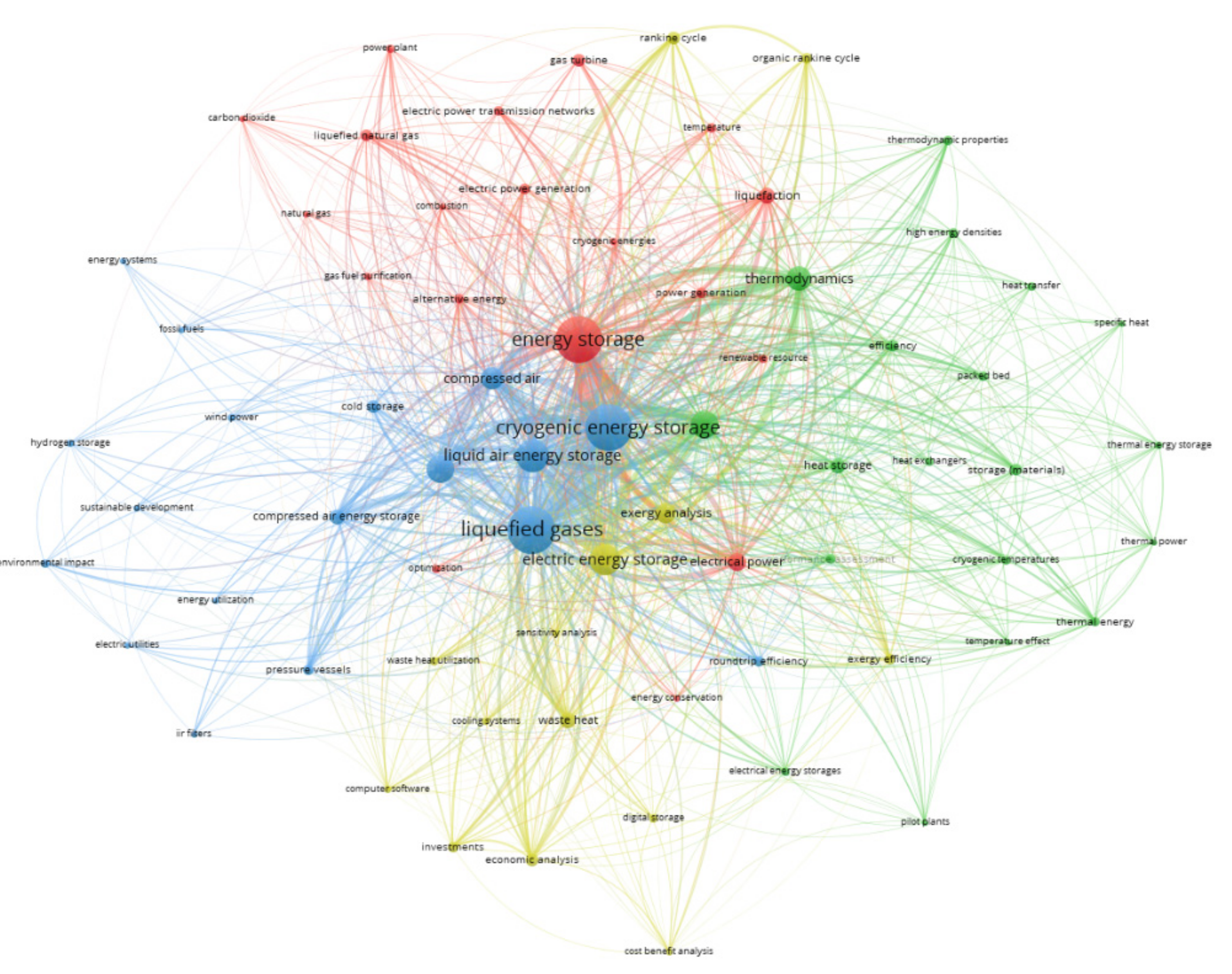
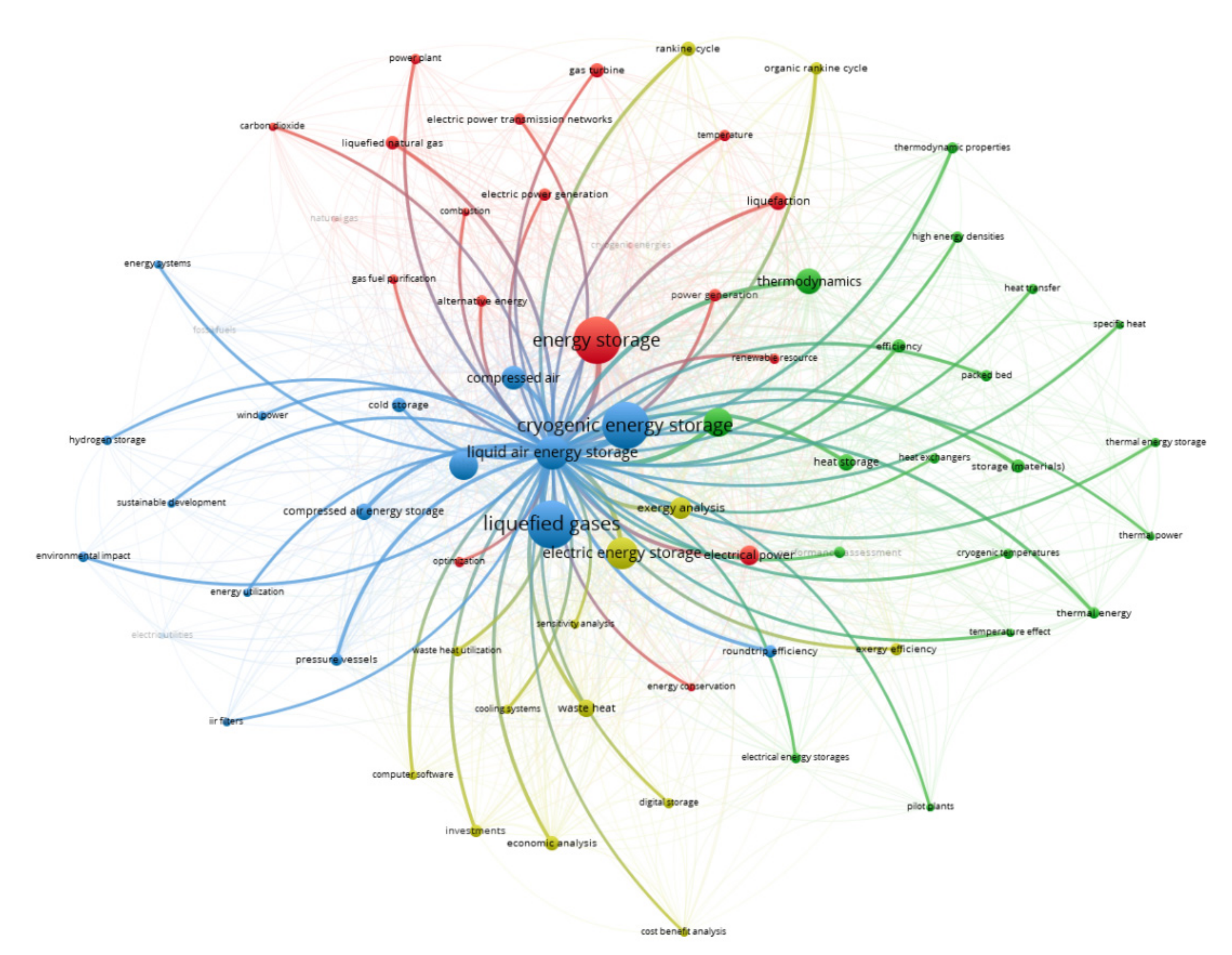


| Journal | Number of Publications in this Query | Category | Impact Factor (in 2018) | Full Open Access |
|---|---|---|---|---|
| Applied Energy | 21 | Q1 | 8.26 | No |
| Energy Procedia | 18 | --- | --- | Yes |
| Energy | 10 | Q1 | 5.53 | No |
| Applied Thermal Engineering | 6 | Q1 | 4.02 | No |
| IOP Conference Series Materials Science And Engineering | 5 | --- | --- | Yes |
| Nihon Kikai Gakkai Ronbunshu B Hen Transactions Of The Japan Society Of Mechanical Engineers Part B | 4 | --- | --- | Yes |
| Energy Conversion And Management | 3 | Q1 | 7.18 | No |
| Journal Of Cleaner Production | 3 | Q1 | 7.32 | - |
| Energies | 2 | Q2 | 2.67 | Yes |
| Entropy | 2 | Q2 | 2.30 | No |
| Heat Transfer Asian Research | 2 | --- | --- | No |
| Journal of Energy Storage | 2 | Q2 | 3.51 | No |
| Kung Cheng Je Wu Li Hsueh Pao Journal Of Engineering Thermophysics | 2 | --- | --- | --- |
| Power | 2 | --- | --- | --- |
| Proceedings Of The ASME Turbo Expo | 2 | --- | --- | Yes |
| Affiliation | Country | Publications |
|---|---|---|
| University of Birmingham | United Kingdom | 25 |
| Nanyang Technological University, ERI@N | Singapore | 12 |
| University of Chinese Academy of Sciences | China | 11 |
| Università Politecnica delle Marche | Italy | 9 |
| Hitachi, Ltd. | Japan | 7 |
| Technical University of Berlin | Germany | 5 |
| University of Brighton | United Kingdom | 4 |
| University of Science and Technology Beijing | China | 4 |
| Tsinghua University | China | 4 |
| Università di Pisa | Italy | 4 |
| Author | Institution | Country | Publications on the LAES | Total Documents | h-Index in Scopus |
|---|---|---|---|---|---|
| Ding, Y.* | University of Birmingham | UK | 16 | (300 + 51) | 54 |
| Li, Y. | University of Birmingham | UK | 13 | 76 | 18 |
| Romagnoli, A. | Nanyang Technological University, ER | Singapore | 12 | 125 | 17 |
| Comodi, G. | Università Politecnica delle Marche | Italy | 9 | 71 | 17 |
| Peng, X. | University of Birmingham | UK | 9 | 14 | 5 |
| She, X. | University of Birmingham | UK | 9 | 34 | 11 |
| Tafone, A. | Nanyang Technological University, ER | Singapore | 9 | 12 | 4 |
| Borri, E. | Università Politecnica delle Marche | Italy | 8 | 9 | 4 |
| Chino, K. | Hitachi, Ltd. | Japan | 8 | 8 | 2 |
| Al-Dadah, R.* | University of Birmingham | UK | 6 | 135 | 22 |
| Related to Energy Storage | Related to the Type of Study | Related to the Energy Systems and Components | Others |
|---|---|---|---|
| Cryogenic energy storage | Thermodynamics | Rankine cycle | Liquefied gases |
| Energy storage | Exergy analysis | Storage (materials) | Waste heat |
| Electric energy storage | Economic analysis | Pressure vessels | Combustion |
| Liquid air energy storage | Optimization | Packed bed | Liquefied natural gas |
| Compressed air energy storage | Cost benefit analysis | Gas turbine | --- |
| --- | Environmental impact | Heat exchangers | --- |
| --- | Sustainable development | Cooling systems | --- |
| --- | Sensitivity analysis | Pilot plants | --- |
| --- | --- | Organic Rankine cycle | --- |
© 2020 by the authors. Licensee MDPI, Basel, Switzerland. This article is an open access article distributed under the terms and conditions of the Creative Commons Attribution (CC BY) license (http://creativecommons.org/licenses/by/4.0/).
Share and Cite
Borri, E.; Tafone, A.; Zsembinszki, G.; Comodi, G.; Romagnoli, A.; Cabeza, L.F. Recent Trends on Liquid Air Energy Storage: A Bibliometric Analysis. Appl. Sci. 2020, 10, 2773. https://doi.org/10.3390/app10082773
Borri E, Tafone A, Zsembinszki G, Comodi G, Romagnoli A, Cabeza LF. Recent Trends on Liquid Air Energy Storage: A Bibliometric Analysis. Applied Sciences. 2020; 10(8):2773. https://doi.org/10.3390/app10082773
Chicago/Turabian StyleBorri, Emiliano, Alessio Tafone, Gabriel Zsembinszki, Gabriele Comodi, Alessandro Romagnoli, and Luisa F. Cabeza. 2020. "Recent Trends on Liquid Air Energy Storage: A Bibliometric Analysis" Applied Sciences 10, no. 8: 2773. https://doi.org/10.3390/app10082773
APA StyleBorri, E., Tafone, A., Zsembinszki, G., Comodi, G., Romagnoli, A., & Cabeza, L. F. (2020). Recent Trends on Liquid Air Energy Storage: A Bibliometric Analysis. Applied Sciences, 10(8), 2773. https://doi.org/10.3390/app10082773










